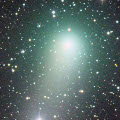
|
Now it is 7.0 mag (Aug. 27, Juan Jose Gonzalez). It keeps so bright as 6-8 mag for a long time from 2011 to 2012, and will be observable in good condition in the Northern Hemisphere. In the Southern Hemisphere, it keeps observable in good condition until October when it brightens up to 6.5 mag.
Date(TT) R.A. (2000) Decl. Delta r Elong. m1 Best Time(A, h)
Sept. 3 19 26.10 19 39.2 1.424 2.153 123 6.9 20:35 ( 0, 75)
Sept.10 19 1.40 19 55.7 1.474 2.092 113 6.9 19:43 ( 0, 75)
|
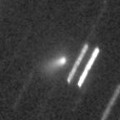
|
It passed very near by the earth, within 0.1 A.U., and brightened up to 8.0 mag in the southern sky (Aug. 14, Willian Souza). Now it is not observable. In the Northern Hemisphere, it will appear in the morning sky at 7 mag in mid September, then it keeps observable while fading gradually. In the Southern Hemisphere, it is not observable until winter when it becomes fainter than 16 mag.
Date(TT) R.A. (2000) Decl. Delta r Elong. m1 Best Time(A, h)
Sept. 3 9 31.20 2 59.1 0.281 0.749 19 8.6 4:06 (262, -6)
Sept.10 9 39.88 6 28.9 0.397 0.660 22 8.0 4:12 (263, 1)
|
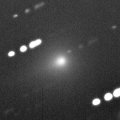
|
It has brightened faster than expected, and reached up to 8.1 mag in mid August (Aug. 19, Michael Mattiazzo). However, it turned to be fading and getting diffuse rapidly after that. Altnough it was expected to be a naked eye comet, the nucleus is disintegrating and the comet will disappear soon. It is not observable for a while in the Northern Hemisphere. It will be unobservable also in the Southern Hemisphere in early September. After appearing in the morning sky in October, it becomes observable in the excellent condition at midnight. However, the comet can be already too faint to see.
Date(TT) R.A. (2000) Decl. Delta r Elong. m1 Best Time(A, h)
Sept. 3 12 38.62 -4 59.6 0.906 0.519 30 9.8 19:52 ( 86, -3)
Sept.10 12 48.95 -5 41.1 0.730 0.483 26 10.1 19:41 ( 86, -5)
|
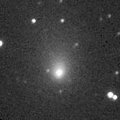
|
Now it is 10.0 mag, much brighter than expected (Aug. 8, Juan Jose Gonzalez). It will brighten up to 10-11 mag in autumn. In the Northern Hemisphere, it keeps observable for a long time until 2012 spring, although it became low temporarily in July. In the Southern Hemisphere, it is not observable until November.
Date(TT) R.A. (2000) Decl. Delta r Elong. m1 Best Time(A, h)
Sept. 3 7 58.68 55 5.8 2.326 1.981 57 10.7 4:06 (223, 35)
Sept.10 7 56.79 54 1.3 2.233 1.983 62 10.7 4:12 (225, 40)
|

|
It will pass the perihelion on Sept. 8. It will brighten up to 5-6 mag. But it locates extremely close to the Sun, and it is not observable on the ground.
Date(TT) R.A. (2000) Decl. Delta r Elong. m1 Best Time(A, h)
Sept. 3 11 37.82 -1 50.7 0.911 0.286 16 18.3 19:52 ( 98,-14)
Sept.10 11 5.12 6 40.7 1.124 0.124 2 11.6 4:12 (250,-16)
|
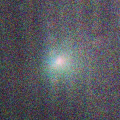
|
New comet discovered in the spacecraft images. Now it is so bright as 11 mag (Sept. 5, Terry Lovejoy). In the Southern Hemisphere, it must have located high and been observable in excellent condition from spring to summer. It locates high still now. But it will be getting lower in the evening sky after this, and it will be unobservable in late September. In the Northern Hemisphere, it locates extremely low and hard to observe. It will appear in the morning sky at 15 mag in late November, then it will be observable while fading gradually.
Date(TT) R.A. (2000) Decl. Delta r Elong. m1 Best Time(A, h)
Sept. 3 14 12.92 -22 55.2 1.294 1.163 59 12.2 19:52 ( 58, 4)
Sept.10 14 14.22 -18 19.0 1.467 1.140 50 12.4 19:41 ( 64, 5)
|
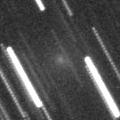
|
It will approach to the sun down to 0.9 A.U. in early September. Extremely diffuse. It is faint as 15.0 mag by CCD observations (Aug. 20, Michael Jager). The central part is extremely faint as 18 mag. However, it was reported so bright as 9.5 mag visually (Aug. 26, Juan Jose Gonzalez). In the Northern Hemisphere, it keeps observable until winter, although it becomes very low from mid August to late September. In the Southern Hemisphere, it is not observable until November. It will keep the current brightness until autumn in calculation. However, it may be disintegrated in the near future.
Date(TT) R.A. (2000) Decl. Delta r Elong. m1 Best Time(A, h)
Sept. 3 10 38.33 42 11.1 1.528 0.900 34 12.5 4:06 (222, 7)
Sept.10 10 51.24 35 42.7 1.598 0.897 30 12.6 4:12 (229, 5)
|
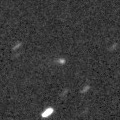
|
It brightened up to 15.0 mag on July 10 (Ken-ichi Kadota). Now it is not observable. The condition of this apparition is bad. In the Northern Hemisphere, it is only observable from December to February in the evening very low sky after the perihelion passage. In the Southern Hemisphere, it keeps observable for a long time, although it keeps locating extremely low. The component B was not detected, fainter than 20 mag, on May 14 (Hidetaka Sato).
Date(TT) R.A. (2000) Decl. Delta r Elong. m1 Best Time(A, h)
Sept. 3 12 40.13 -0 5.0 1.898 1.134 29 12.9 19:52 ( 90, 0)
Sept.10 13 2.07 -3 14.2 1.850 1.084 28 12.8 19:41 ( 86, -1)
|
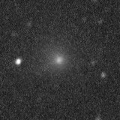
|
It has returned after 27-year blank since 1984. It brightened very rapidly, and became very bright as 9.1 mag (July 10, Tsutomu Seki). However, it is not observable now. It will never be observable again in this apparition.
Date(TT) R.A. (2000) Decl. Delta r Elong. m1 Best Time(A, h)
Sept. 3 9 50.25 -1 30.2 1.855 0.936 16 12.8 4:06 (263,-13)
Sept.10 10 16.89 -5 20.4 1.932 1.015 17 13.6 4:12 (267,-13)
|
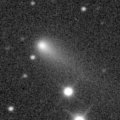
|
Already bright and visible visually at 12.6 mag (Sept. 1, Marco Goiato). It will be observable in good condition at 12 mag in autumn and winter.
Date(TT) R.A. (2000) Decl. Delta r Elong. m1 Best Time(A, h)
Sept. 3 23 59.10 7 10.1 1.312 2.272 156 13.1 1:13 ( 0, 62)
Sept.10 23 56.09 6 38.7 1.263 2.248 163 12.9 0:43 ( 0, 62)
|
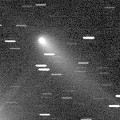
|
First return of a new periodic comet which brightened up to 13 mag in a major outburst in 2005. Now it is very bright as 11.2 mag (Aug. 26, Juan Jose Gonzalez). It will be observable in an excellent condition from summer to winter. The fragment B is also observed at 19-20 mag.
Date(TT) R.A. (2000) Decl. Delta r Elong. m1 Best Time(A, h)
Sept. 3 23 0.76 4 27.9 1.202 2.197 167 13.2 0:15 ( 0, 60)
Sept.10 22 54.99 4 33.1 1.213 2.211 169 13.3 23:37 ( 0, 60)
|
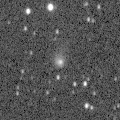
|
Now it is so bright as 13.0 mag (Sept. 1, Hidetaka Sato). It keeps bright as 13-14 mag for a long time after this until 2013. It is not observable in the Northern Hemisphere, but it is observable in good condition in the Southern Hemisphere.
Date(TT) R.A. (2000) Decl. Delta r Elong. m1 Best Time(A, h)
Sept. 3 11 24.44 -74 41.1 5.562 5.526 82 13.5 19:52 ( 19,-39)
Sept.10 11 31.67 -74 58.9 5.598 5.518 80 13.5 19:41 ( 18,-39)
|
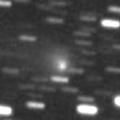
|
Now it is 13.6 mag and visible visually (Aug. 24, Jakub Koukal). It will be observable at 13-14 mag for a long time from 2011 to 2012.
Date(TT) R.A. (2000) Decl. Delta r Elong. m1 Best Time(A, h)
Sept. 3 18 14.68 -9 23.8 4.936 5.410 112 14.0 19:52 ( 9, 45)
Sept.10 18 9.54 -9 50.9 5.042 5.393 105 14.0 19:41 ( 16, 44)
|
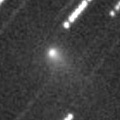
|
It was very bright and visible visually as 12.4 mag in July and early August (Aug. 2, Jakub Koukal). Now it is fading rapidly. Now it is 13.5 mag (Aug. 26, Jakub Cerny). In the Northern Hemisphere, it keeps observable at 14-15 mag in good condition until autumn. It locates low in the Southern Hemisphere.
Date(TT) R.A. (2000) Decl. Delta r Elong. m1 Best Time(A, h)
Sept. 3 18 2.89 33 58.6 1.480 1.946 101 14.1 19:52 ( 86, 82)
Sept.10 17 50.38 34 10.0 1.595 1.961 95 14.4 19:41 ( 91, 76)
|
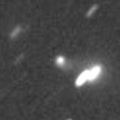
|
Now it is 13.5 mag, much brighter than expected (Aug. 20, Michael Jager). It keeps 14 mag from 2011 summer to 2012 summer. But it is not observable around the perihelion. It is observable in good condition in the Northern Hemisphere in 2011, and in the Southern Hemisphere in 2012. It was reported that it is very bright as 10.3 mag with a large coma of 6 arcmin visually (Aug. 26, Juan Jose Gonzalez). However, it looks very small by CCD images.
Date(TT) R.A. (2000) Decl. Delta r Elong. m1 Best Time(A, h)
Sept. 3 14 23.88 8 14.0 3.080 2.615 53 14.2 19:52 ( 81, 26)
Sept.10 14 34.66 6 34.3 3.102 2.582 50 14.1 19:41 ( 81, 24)
|

|
Now it is not observable. It will appear in the morning sky in early November.
Date(TT) R.A. (2000) Decl. Delta r Elong. m1 Best Time(A, h)
Sept. 3 11 31.38 -3 7.8 7.226 6.261 15 14.3 19:52 ( 97,-16)
Sept.10 11 36.11 -3 40.1 7.247 6.261 10 14.3 19:41 ( 99,-19)
|

|
Big asteroid discovered in 1906. It suddenly showed the cometary activity on Dec. 11, probably due to an impact of a small object. It was very bright as 11.5 mag visually (Dec. 17, Juan Jose Gonzalez). It had a dust coma still on Jan. 9 (Joseph Brimacombe). Then it turned to be stellar at 13.8 mag (Apr. 5, Juan Jose Gonzalez). Now it is not observable.
Date(TT) R.A. (2000) Decl. Delta r Elong. m1 Best Time(A, h)
Sept. 3 11 54.76 11 44.0 3.625 2.679 17 14.3 19:52 (106, -2)
Sept.10 12 5.79 10 21.7 3.632 2.669 14 14.3 19:41 (106, -4)
|

|
It is not observable at all due to the bad condition in this apparition.
Date(TT) R.A. (2000) Decl. Delta r Elong. m1 Best Time(A, h)
Sept. 3 11 8.41 11 44.3 2.556 1.558 6 14.3 19:52 (113,-11)
Sept.10 11 28.13 9 49.3 2.592 1.594 6 14.6 19:41 (111,-12)
|
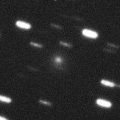
|
New bright comet at 14.5 mag (Aug. 26, R. H. McNaught). It is observable in good condition in the Southern Hemisphere. But it will be getting lower, and will be unobservable in early November. It will brighten up to 11-12 mag in winter, however, it is not observable around the perihelion passage. In the Northern Hemisphere, it is not observable until 2012 summer, when it will be fainter than 15 mag.
Date(TT) R.A. (2000) Decl. Delta r Elong. m1 Best Time(A, h)
Sept. 3 14 2.74 -37 23.2 2.612 2.358 64 14.5 19:52 ( 48, -7)
Sept.10 14 16.94 -36 47.6 2.611 2.286 60 14.4 19:41 ( 49, -7)
|
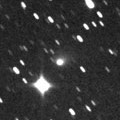
|
It brightened rapidly. Now it is bright and visible visually at 14.2 mag (Aug. 7, Alan Hale). It will be observable at 15 mag in good condition from July to October. It locates somewhat low in the Northern Hemisphere.
Date(TT) R.A. (2000) Decl. Delta r Elong. m1 Best Time(A, h)
Sept. 3 20 13.36 -27 13.3 1.450 2.308 138 15.0 21:24 ( 0, 28)
Sept.10 20 13.84 -27 43.8 1.504 2.305 132 15.0 20:57 ( 0, 27)
|
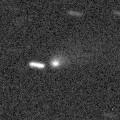
|
Appearing in the morning sky, it was revealed to be a comet. Now it is very bright as 14.7 mag (Aug. 1, G. V. Borisov, V. Rumyantsev). It has already passed the perihelion in April, and it will be fading after this. But it is still bright as 14.6 mag (Aug. 29, Jakub Cerny). In the Northern Hemisphere, it keeps observable in excellent condition for a long time until 2012 summer. It is not observable at all in the Southern Hemisphere. If the current brightness is temporal, it may fade out rapidly.
Date(TT) R.A. (2000) Decl. Delta r Elong. m1 Best Time(A, h)
Sept. 3 8 37.48 48 20.0 2.835 2.299 48 15.1 4:06 (229, 28)
Sept.10 8 58.19 48 20.2 2.833 2.344 51 15.2 4:12 (229, 30)
|

|
It brightened up to 17.1 mag in late June (June 24, J. F. Hernandez). It will brighten up to 13 mag in winter. But the condition of this apparition is bad, and it will not be observable around the perihelion passage. It is already too low to observe in the Northern Hemisphere. It will be unobservable soon also in the Southern Hemisphere.
Date(TT) R.A. (2000) Decl. Delta r Elong. m1 Best Time(A, h)
Sept. 3 12 56.32 -2 34.9 2.594 1.847 34 15.3 19:52 ( 85, 2)
Sept.10 13 11.06 -4 31.3 2.597 1.815 31 15.1 19:41 ( 84, 0)
|
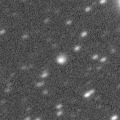
|
Brightening rapidly. Now it is visible visually at 13.5 mag (Aug. 28, Jakub Cerny). It is expected to be 13 mag and will be observable in good condition in 2013. In the Northern Hemisphere, it keeps observable for a long time after this. It is not observable in the Southern Hemisphere.
Date(TT) R.A. (2000) Decl. Delta r Elong. m1 Best Time(A, h)
Sept. 3 1 23.80 65 22.9 7.060 7.325 101 15.2 2:38 (180, 60)
Sept.10 1 12.51 65 45.1 6.960 7.297 105 15.2 2:00 (180, 59)
|
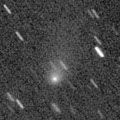
|
Now it is fading slowly, but still bright and visible visually as 13.8 mag (Aug. 29, Jakub Cerny). It will keep 14-15 mag until mid September.
Date(TT) R.A. (2000) Decl. Delta r Elong. m1 Best Time(A, h)
Sept. 3 22 51.96 -19 43.4 2.402 3.396 168 15.2 0:07 ( 0, 35)
Sept.10 22 41.58 -22 28.1 2.474 3.443 161 15.3 23:24 ( 0, 32)
|

|
It was expected to keep 14-15 mag for a long time from 2011 summer to 2012 summer. However, it is lost. It was observed only during two days in 2010 June. So the orbital elements are extremely uncertain. The condition is good in the Southern Hemisphere. But in the Northern Hemisphere, it is not observable until 2012 August.
Date(TT) R.A. (2000) Decl. Delta r Elong. m1 Best Time(A, h)
Sept. 3 15 37.58 -52 35.7 2.780 2.890 86 15.3 19:52 ( 26, -6)
Sept.10 15 37.10 -53 7.0 2.834 2.846 80 15.3 19:41 ( 28, -8)
|
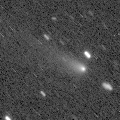
|
Now it is bright and visible visually at 14.5 mag (Aug. 29, Jakub Cerny). Brighter than originally predicted. It will be observable at 14-15 mag in good condition from summer to autumn.
Date(TT) R.A. (2000) Decl. Delta r Elong. m1 Best Time(A, h)
Sept. 3 23 10.07 -19 19.4 1.168 2.164 167 15.7 0:25 ( 0, 36)
Sept.10 23 5.70 -19 49.6 1.188 2.177 165 15.8 23:48 ( 0, 35)
|
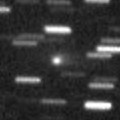
|
Brightening rapidly. Now it is 15.5 mag (Aug. 9, Hidetaka Sato). It will be obserbale at 14 mag in good condition in autumn. It locates somewhat low in the Southern Hemisphere.
Date(TT) R.A. (2000) Decl. Delta r Elong. m1 Best Time(A, h)
Sept. 3 6 32.66 8 31.4 1.682 1.513 62 16.1 4:06 (284, 33)
Sept.10 6 54.92 8 38.0 1.630 1.488 63 15.9 4:12 (286, 36)
|
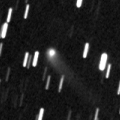
|
Now it is 15.8 mag (Aug. 16, Artyom Novichonok). It will be fading very slowly after this. In the Northern Hemisphere, it keeps observable for a long time until 2012 spring when it fades down to 17-18 mag. It will not be observable in the Southern Hemisphere.
Date(TT) R.A. (2000) Decl. Delta r Elong. m1 Best Time(A, h)
Sept. 3 22 39.80 52 10.3 4.684 5.261 119 16.1 23:50 (180, 73)
Sept.10 22 36.41 51 31.5 4.676 5.289 122 16.1 23:19 (180, 73)
|
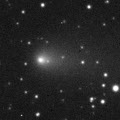
|
It became bright as 12 mag in 2010. Now it is fading. It has already faded down to 16.8 mag (Aug. 2, J.F. Soulier and A. Novichonok).
Date(TT) R.A. (2000) Decl. Delta r Elong. m1 Best Time(A, h)
Sept. 3 2 20.33 4 9.2 3.071 3.746 125 16.1 3:34 ( 0, 59)
Sept.10 2 18.64 3 54.1 3.012 3.765 132 16.1 3:05 ( 0, 59)
|

|
It has brightened in outburst up to 14 mag in 2006 January. Another outburst occured in late May, and brightened up to 14.3 mag (June 4, Juan Jose Gonzalez). It was bright as 14.5 mag still on June 27 (Jakub Koukal). Recent brightness has not been reported. It will be getting lower in the evening sky after this, and will be unobservable in October.
Date(TT) R.A. (2000) Decl. Delta r Elong. m1 Best Time(A, h)
Sept. 3 16 5.06 -16 33.5 8.335 8.264 82 16.1 19:52 ( 42, 27)
Sept.10 16 6.80 -16 41.4 8.427 8.245 76 16.3 19:41 ( 45, 24)
|
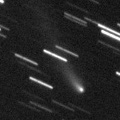
|
It reached up to 14 mag in 2010 autumn and winter. Now it is fading. In the Southern Hemisphere, it keeps observable in good condition while fading gradually. In the Northern Hemisphere, it will never be observable again. It must be still bright, but no observations have been reported since May.
Date(TT) R.A. (2000) Decl. Delta r Elong. m1 Best Time(A, h)
Sept. 3 6 28.70 -50 55.6 3.608 3.583 80 16.1 4:06 (329, -8)
Sept.10 6 32.14 -53 58.3 3.611 3.622 82 16.2 4:12 (334, -8)
|
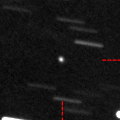
|
It is expected to be bright as 9 mag from 2012 to 2013. Now it is 16.5 mag (Aug. 11, V. Gerke, A. Novichonok). In the Northern Hemisphere, although it becomes low temporarily in 2011 autumn, it keeps observable in good condition for a long time until 2012 autumn when the comet brightens up to 10 mag. In the Southern Hemisphere, it is hardly observble before the perihelion passage. But it becomes observable in good condition since 2013 after the perihelion passage.
Date(TT) R.A. (2000) Decl. Delta r Elong. m1 Best Time(A, h)
Sept. 3 12 33.40 50 26.1 6.231 5.607 48 16.5 19:52 (135, 25)
Sept.10 12 40.98 49 35.7 6.168 5.548 48 16.4 19:41 (135, 24)
|
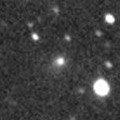
|
Now it is 16.0 mag (Aug. 19, J. F. Hernandez). It is visible visually at 15.0 mag (Aug. 23, Jakub Cerny). It will brighten up to 16 mag from summer to autumn, and will be observable in good condition.
Date(TT) R.A. (2000) Decl. Delta r Elong. m1 Best Time(A, h)
Sept. 3 16 52.59 -9 8.3 1.743 2.056 92 16.4 19:52 ( 35, 39)
Sept.10 17 3.48 -10 8.0 1.802 2.049 88 16.5 19:41 ( 36, 37)
|
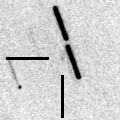
|
Now it is 16.6 mag (July 22, Hidetaka Sato). In the Southern Hemisphere, it keeps observable at 16-17 mag for a long time from summer to winter. It is not observable in the Northern Hemisphere.
Date(TT) R.A. (2000) Decl. Delta r Elong. m1 Best Time(A, h)
Sept. 3 14 47.35 -76 30.2 1.796 2.075 91 16.4 19:52 ( 13,-27)
Sept.10 14 20.77 -73 59.9 1.884 2.047 84 16.5 19:41 ( 17,-28)
|

|
New comet. Now it is 16.3 mag (Sept. 4, Siding Spring Survey). It is expected to be observable at 13 mag for a long time from 2012 summer to 2013 summer. It will be observable in excellent condition in the Southern Hemisphere. But it is not observable at brightest time in the Northern Hemisphere. It keeps observable for a while at 16 mag while brightening gradually.
Date(TT) R.A. (2000) Decl. Delta r Elong. m1 Best Time(A, h)
Sept. 3 3 2.88 -15 0.6 4.499 5.036 116 16.8 4:06 (356, 40)
Sept.10 3 0.37 -16 38.6 4.366 4.985 122 16.7 3:47 ( 0, 38)
|
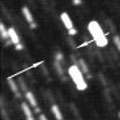
|
Now it is 16.5 mag (Aug. 1, Hidetaka Sato). In the Southern Hemisphere, it keeps observable at 16-17 mag for a long time from 2011 to 2013. In the Northern Hemisphere, it is only observable until October.
Date(TT) R.A. (2000) Decl. Delta r Elong. m1 Best Time(A, h)
Sept. 3 17 6.96 -21 5.8 4.666 4.903 97 16.7 19:52 ( 25, 30)
Sept.10 17 6.72 -21 56.5 4.748 4.869 90 16.8 19:41 ( 29, 27)
|
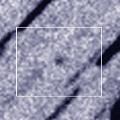
|
Now it is 17.0 mag (Aug. 27, Artyom Novichonok). It will reach up to 10 mag from January to March, but it will be too low to observe. It will be getting lower in the evening sky. In the Northern Hemisphere, it keeps observable until December when it brightens up to 12 mag. In the Southern Hemisphere, it is observable only until October when it becomes 15 mag.
Date(TT) R.A. (2000) Decl. Delta r Elong. m1 Best Time(A, h)
Sept. 3 15 32.53 8 50.7 2.349 2.230 70 17.0 19:52 ( 70, 40)
Sept.10 15 39.78 7 48.8 2.361 2.168 66 16.8 19:41 ( 71, 37)
|
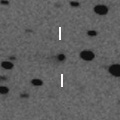
|
Now it is 16.6 mag (Aug. 29, Artyom Novichonok). It keeps observable at 17 mag for a long time from 2011 to 2012.
Date(TT) R.A. (2000) Decl. Delta r Elong. m1 Best Time(A, h)
Sept. 3 0 33.88 18 30.3 7.211 8.035 142 16.8 1:48 ( 0, 74)
Sept.10 0 28.54 18 11.2 7.152 8.038 149 16.8 1:15 ( 0, 73)
|
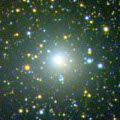
|
It reached up to 7.7 mag in 2009 summer (2009 Aug. 13, Chris Wyatt). Now it is fading. It has already faded down to 15.3 mag (June 29, Hidetaka Sato). It will never be observable again in the Northern Hemisphere. In the Southern Hemisphere, it keeps observable in good condition until autumn when it becomes fainter than 18 mag. No observations have been reported since July.
Date(TT) R.A. (2000) Decl. Delta r Elong. m1 Best Time(A, h)
Sept. 3 15 18.53 -59 36.1 7.504 7.501 85 17.2 19:52 ( 24,-13)
Sept.10 15 19.15 -59 12.3 7.646 7.549 80 17.3 19:41 ( 25,-14)
|
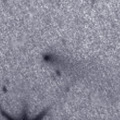
|
Although the condition is bad in this apparition, it brightened up to 12.8 mag in last winter (Dec. 24, Ken-ichi Kadota). Now it is fading. It has already faded down to 16.5 mag (Aug. 21, P. Dupouy, P. A. Mahe). It will be fainter than 18 mag in late September.
Date(TT) R.A. (2000) Decl. Delta r Elong. m1 Best Time(A, h)
Sept. 3 0 12.54 -16 53.6 1.597 2.556 157 17.2 1:27 ( 0, 38)
Sept.10 0 5.61 -17 33.7 1.620 2.597 161 17.4 0:53 ( 0, 38)
|
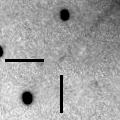
|
New comet discovered by de la Cueva, et al., Spain. Now it is 17.3 mag (Aug. 22, J. L. Ortiz, N. Morales, I. de la Cueva). It keeps 17-18 mag until early 2013. It keeps observable in good condition until early 2012 in the Southern Hemisphere, although it locates low in the Northern Hemisphere. In the Northern Hemisphere, it will be observable in good condition from 2012 autumn to early 2013.
Date(TT) R.A. (2000) Decl. Delta r Elong. m1 Best Time(A, h)
Sept. 3 1 15.78 -45 10.5 2.729 3.472 130 17.6 2:30 ( 0, 10)
Sept.10 1 12.43 -45 57.1 2.693 3.445 131 17.5 1:59 ( 0, 9)
|
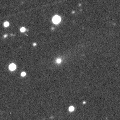
|
Now it is 16.5 mag (July 2, J. F. Hernandez). It was observed around 16 mag in 2009 and 2010. In 2011, it keeps observable at 17 mag from spring to autumn. It locates somewhat low in the Northern Hemisphere.
Date(TT) R.A. (2000) Decl. Delta r Elong. m1 Best Time(A, h)
Sept. 3 16 57.17 -24 9.8 4.026 4.246 95 17.6 19:52 ( 26, 26)
Sept.10 17 0.41 -24 17.5 4.140 4.254 89 17.7 19:41 ( 29, 25)
|

|
Peculiar asteroid moving along a cometary orbit. It will pass the perihelion in winter. But it will never be brighter than 18 mag. It becomes observable in good condition in September in the Southern Hemisphere. It locates low in the Northern Hemisphere.
Date(TT) R.A. (2000) Decl. Delta r Elong. m1 Best Time(A, h)
Sept. 3 0 21.69 -35 13.1 2.386 3.263 144 17.9 1:36 ( 0, 20)
Sept.10 0 18.82 -36 12.6 2.371 3.251 145 17.9 1:06 ( 0, 19)
|
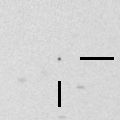
|
Peculiar asteroid moving along a cometary orbit. Now it is 17.5 mag (Aug. 1, Siding Spring Survey)�$B!#�(BIt is observable at 17-18 mag in good condition from September to November.
Date(TT) R.A. (2000) Decl. Delta r Elong. m1 Best Time(A, h)
Sept. 3 3 15.00 12 35.5 1.879 2.420 110 18.0 4:06 (345, 67)
Sept.10 3 15.54 12 1.0 1.850 2.475 116 17.9 4:02 ( 0, 67)
|
|
![]()
 C/2011 Q4 ( SWAN )
C/2011 Q4 ( SWAN ) C/2011 M1 ( LINEAR )
C/2011 M1 ( LINEAR ) 73P/Schwassmann-Wachmann 3
73P/Schwassmann-Wachmann 3 27P/Crommelin
27P/Crommelin 78P/Gehrels 2
78P/Gehrels 2 213P/2009 B3 ( Van Ness )
213P/2009 B3 ( Van Ness ) C/2009 F4 ( McNaught )
C/2009 F4 ( McNaught ) C/2006 S3 ( LONEOS )
C/2006 S3 ( LONEOS ) C/2011 L3 ( McNaught )
C/2011 L3 ( McNaught ) C/2011 A3 ( Gibbs )
C/2011 A3 ( Gibbs ) 29P/Schwassmann-Wachmann 1
29P/Schwassmann-Wachmann 1 (596) Scheila
(596) Scheila 62P/Tsuchinshan 1
62P/Tsuchinshan 1 C/2011 Q2 ( McNaught )
C/2011 Q2 ( McNaught ) 48P/Johnson
48P/Johnson P/2010 JC81 ( WISE )
P/2010 JC81 ( WISE ) 71P/Clark
71P/Clark C/2010 S1 ( LINEAR )
C/2010 S1 ( LINEAR ) C/2009 Y1 ( Catalina )
C/2009 Y1 ( Catalina ) C/2010 M1 ( Gibbs )
C/2010 M1 ( Gibbs ) 130P/McNaught-Hughes
130P/McNaught-Hughes 49P/Arend-Rigaux
49P/Arend-Rigaux C/2008 FK75 ( Lemmon-Siding Spring )
C/2008 FK75 ( Lemmon-Siding Spring ) 65P/Gunn
65P/Gunn 174P/(60558) 2000 EC98 ( Echeclus )
174P/(60558) 2000 EC98 ( Echeclus ) C/2010 B1 ( Cardinal )
C/2010 B1 ( Cardinal ) C/2011 F1 ( LINEAR )
C/2011 F1 ( LINEAR ) 115P/Maury
115P/Maury C/2011 L2 ( McNaught )
C/2011 L2 ( McNaught ) C/2011 R1 ( McNaught )
C/2011 R1 ( McNaught ) C/2011 O1 ( LINEAR )
C/2011 O1 ( LINEAR ) 21P/Giacobini-Zinner
21P/Giacobini-Zinner C/2008 S3 ( Boattini )
C/2008 S3 ( Boattini ) C/2006 W3 ( Christensen )
C/2006 W3 ( Christensen ) 9P/Tempel 1
9P/Tempel 1 P/2011 N1
P/2011 N1 74P/Smirnova-Chernykh
74P/Smirnova-Chernykh 2010 GM163
2010 GM163 2000 EJ37
2000 EJ37![]()






































